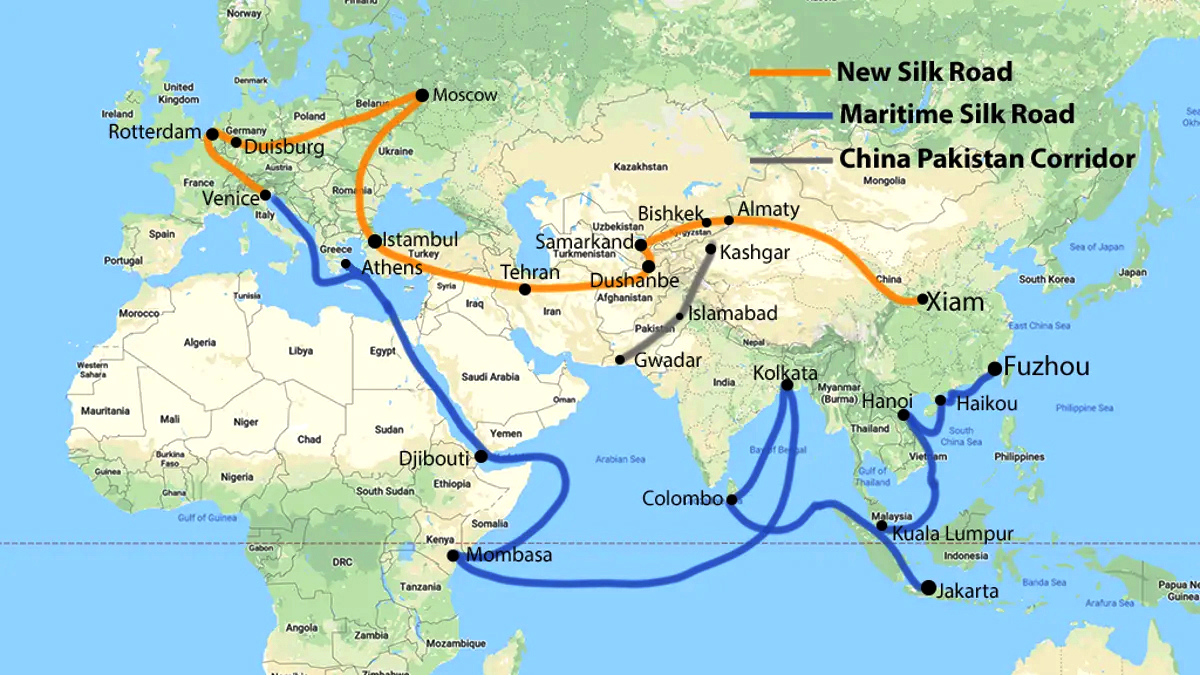Decline in China’s BRI Investments | 23 Dec 2021
For Prelims: Belt and Road Initiative (BRI), Build Back Better World, Blue Dot Network, Global Gateway
For Mains: BRI and its reach, implications and consequences, Initiatives launched to tackle BRI.
Why in News
According to a China based think tank report, investments in China's much-touted Belt and Road Initiative (BRI) have fallen by 5% since 2019.
- Unsuccessful deals and the Covid-19 pandemic contributed to the fall in the investments.
- Also, China is no longer doling out hard cash for projects in Africa, amid criticism over infrastructure debt and loan defaults.
Key Points
- About BRI:
- It is a multi-billion-dollar initiative launched in 2013.
- It aims to link Southeast Asia, Central Asia, the Gulf region, Africa and Europe with a network of land and sea routes.
- It has been launched to undertake big infrastructure projects in the world which in turn would also enhance the global influence of China.
- More than 100 countries signed agreements with China to cooperate in BRI projects like railways, ports, highways and other infrastructure.
- From 2000 to 2020, China helped African countries build more than 13,000 kms of roads and railways, and more than 80 large-scale power facilities, and funded over 130 medical facilities, 45 sports venues and over 170 schools and built the African Union Conference Centre.
- Activities under BRI:
- It encompassed five kinds of activities:
- Policy coordination, Trade promotion, Physical connectivity, Renminbi internationalization (China’s currency) and People to people contacts.
- It encompassed five kinds of activities:
- Routes of BRI:
- New Silk Road Economic Belt: It encompasses trade and investment hubs to the north of China, by reaching out to Eurasia including a link via Myanmar to India.
- Maritime Silk Road (MSR): It begins via the South China Sea going towards Indo-China, South-East Asia and then around the Indian Ocean thus reaching Africa and Europe.
- Related concerns (for India and World):
- Hamper India’s Strategic Interests:
- The China-Pakistan Economic Corridor (CPEC) passes through Pakistan-occupied Kashmir (PoK) and Baluchistan, both of which are home to a long-running insurgency.
- CPEC would hamper India’s strategic interests in the South Asian region and can aid Pakistan’s legitimacy in the Kashmir dispute too.
- Also, attempts to extend CPEC to Afghanistan may undermine India’s position as economic, security and strategic partner of Afghanistan.
- China’s Strategic Rise in the Subcontinent: Along with China-Myanmar Economic Corridor (CMEC) and CPEC, China is also developing the China-Nepal Economic Corridor (CNEC) which will link Tibet to Nepal.
- The endpoints of the project will touch the boundaries of the Gangetic plain.
- Thus three corridors signify the economic as well as strategic rise of China in the Indian subcontinent.
- Lack of Transparency:
- Lack of transparency of the BRI agreements and mounting debt to China by smaller countries have raised global concerns.
- The 99-year lease of Hambantota port to China by Sri Lanka has raised red flags about the downside of the BRI and push for major infrastructure projects costing billions of dollars in small countries.
- Lack of transparency of the BRI agreements and mounting debt to China by smaller countries have raised global concerns.
- Hamper India’s Strategic Interests:
- Initiatives to Tackle BRI:
- B3W Initiative: The G7 Countries proposed a ‘Build Back Better World (B3W) initiative’ at the 47th G7 summit to counter China’s BRI.
- It aims to address the infrastructure investment deficit in developing and lower income countries - the space which has been increasingly captured by China.
- Blue Dot Network (BDN): It is a multi-stakeholder initiative formed by the US, Japan and Australia to bring together governments, the private sector and civil society to promote high-quality, trusted standards for global infrastructure development.
- BDN was formally announced in november, 2019 at the Indo-Pacific Business Forum in Bangkok, Thailand.
- Global Gateway: In a bid to compete with BRI, the European Union recently launched the Global Gateway, a new infrastructure development scheme.
- B3W Initiative: The G7 Countries proposed a ‘Build Back Better World (B3W) initiative’ at the 47th G7 summit to counter China’s BRI.
Way Forward
- To counter China's BRI, alternative projects must be launched by more advanced countries which are also participatory in nature keeping into account the interests of the host/recipient countries.
- India must seek help from partners like Japan when necessary to build and upgrade its infrastructure and create an alternative to Chinese-led connectivity corridors and infrastructure projects since India’s ability to act alone in South Asia and the larger Indian Ocean is limited.
- For India, it is important to work with its partners in the region to offer alternative connectivity arrangements to its neighbours.
- Connectivity is increasingly seen as a tool for exerting foreign policy influence.

